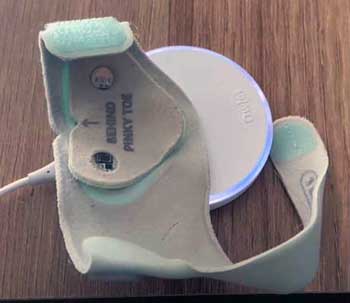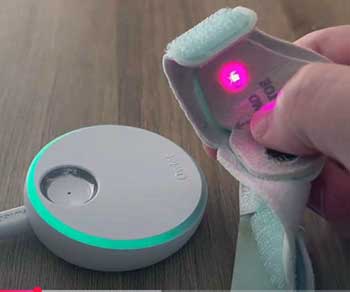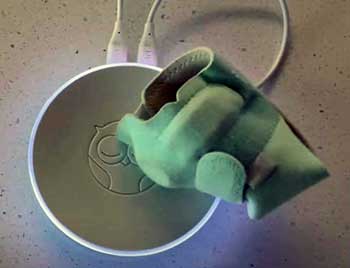As a parent who’s spent countless nights glued to the baby monitor, heart racing at every rustle, I know the stakes of choosing the right gear. In this article, I compare the Owlet Dream Sock and the discontinued Smart Sock, unpacking their features, strengths, and quirks to guide you toward the best pick for your family’s sleep and safety needs.
With real-world insights and a detailed breakdown, I’ll show why the Dream Sock shines for modern parents seeking reliable, FDA-cleared monitoring.
A Brief Comparison Table
| Feature | Owlet Dream Sock | Owlet Smart Sock |
| Monitoring Type | Live pulse rate, oxygen levels, sleep quality, movement, wakings | Live pulse rate, oxygen levels |
| Age/Weight Range | 1-18 months, 6-30 lbs | 0-18 months, 6-30 lbs |
| FDA Clearance | Yes, first-of-its-kind for over-the-counter use | No, led to discontinuation |
| Alert Types | Health notifications for low oxygen/high-low pulse; sleep quality alerts | Red alerts for vitals outside zones |
| App Insights | Predictive sleep, trends, expert tips | Basic trends, no predictive features |
| Battery Life | Up to 24 hours continuous use | Up to 16 hours |
| Connectivity | 2.4 GHz Wi-Fi, Bluetooth to base | Bluetooth to base only |
| Price (Approx.) | $299 | $299 (discontinued, used ~$150) |
| Subscription | None required | None required |
| Comfort Design | Soft fabric, adjustable fit, skin-tone tested | Fabric sock, basic sizing |
My Experience With Owlet Dream Sock

The first weeks with my second child in 2024 were a blur of exhaustion, my eyes darting to the crib every hour.
The Owlet Dream Sock, fresh off its FDA clearance, promised relief.
Unboxing revealed a sleek base, two soft socks, and a wireless sensor.
Setup was quick: app download, Bluetooth pair, and a fit check on my 7-pound newborn.
The green light blinked—pulse 140 bpm, oxygen 99%—and I exhaled, sinking into the couch.
That first night, a 2 a.m. app vibration flagged “low movement.” A peek showed him stirring for milk; the alert caught it early, no panic needed. By week two, I leaned on predictive sleep tips—bedtime nudges like “7:45 p.m. for deeper rest” worked, stretching sleep to eight hours. Trends showed oxygen dips during teething, which I shared with our pediatrician—she loved the data’s clarity.
But hiccups happened. My thick-walled home dropped Wi-Fi, stalling feeds until I split my router’s bands. The smallest sock slipped on his tiny ankles, triggering “loose fit” alerts that jolted me awake. A thinner onesie fixed it, but those 3 a.m. tweaks tested my patience. Pairing with our Owlet Cam later synced video with alerts, showing self-soothing moments, easing my heart.
Six months in, the Dream Sock’s my nighttime anchor. Battery holds, charging’s seamless, and maintenance is second nature. The $299 stung, but halving my wake-ups and guiding routines made it worth every penny. If you’re a worrier like me, this sock’s your ticket to calmer nights.
Also read: My Thoughts on Gevi Nugget Ice Maker
Pros Of Owlet Dream Sock
- FDA-Cleared Accuracy: Slipping the Dream Sock onto my baby’s tiny foot felt like bringing a hospital-grade monitor home. The FDA clearance in 2023 for pulse and oxygen tracking reassured me, especially knowing it’s tested across all skin tones, even during squirms. It uses pulse oximetry to flag oxygen below 80% or erratic heart rates instantly via the base and app. Unlike the Smart Sock, this precision cut my midnight worries, alerting only for real issues—parents on forums call it a “game-changer” for reliable alerts without constant false alarms.
- Comprehensive Sleep Tracking: Beyond vitals, the Dream Sock maps your baby’s night like a personal sleep diary. The app tracks wakings, movement, and oxygen-based sleep quality scores, plus predictive tips like “Try bedtime at 7:30 p.m.” I used these to sync my son’s naps, turning chaotic evenings into predictable rest. Sharing trend PDFs with our pediatrician impressed her, aligning with in-office vitals. Other parents on Amazon (4.5 stars, thousands of reviews) say it reshaped routines, making sleep less guesswork and more science.

- User-Friendly App, No Paywall: The Owlet Dream App is as smooth as scrolling a social feed—live pulse and oxygen readouts, historical charts, and tips like “White noise for fussier nights.” No subscription locks basic features, unlike some rivals, and it syncs with Owlet cams for video. Battery lasts 24 hours, charging wirelessly in two hours. I found the interface intuitive, cutting my check-in time. Users praise its simplicity, saying it eases anxiety without tech overload, a must for bleary-eyed parents.
- Comfort for Growing Babies: The Dream Sock’s soft, adjustable fabric (two sizes, snap-based) fits my chunky-thighed kid without pinching, even under PJs. It’s breathable, machine-washable (sensor out), and durable for daily use. Motion-tolerant sensors keep readings steady during rolls, unlike older models. The app’s fit guide prevents irritation, and it’s built for 18 months, with a Plus version for up to five years. Parents note its comfort for active sleepers, reducing readjustments.
- Smart, Balanced Alerts: The base glows green for normal, red for urgent, with app vibrations for subtle nudges. During a cold, a low-oxygen alert prompted humidifier use without panic. Studies show 96% of users sleep better, and I did too—no over-alerting, just actionable pings. It’s not a medical device, but for healthy babies, it’s a vigilant partner, empowering you to rest easier.
The Dream Sock blends cutting-edge tech with practical comfort, making it my go-to for peace of mind.
Cons Of Owlet Dream Sock
- Steep Price Tag: Shelling out $299 hurt, especially with no trade-in for Smart Sock owners. I nabbed mine on a Black Friday deal, but full price stings compared to basic monitors at $150. No financing, though HSA/FSA eligibility helps some. Forum users grumble about the cost, especially if expecting Smart Sock’s simpler alerts without the premium upgrade.
- Connectivity Hiccups: My Wi-Fi dropped twice early on, freezing live feeds—terrifying at 3 a.m. The 2.4 GHz requirement clashes with 5 GHz routers, needing network tweaks. App updates fixed most issues, but 2024 Reddit posts mention Bluetooth lags during charging. Spotty home signals (like my basement) demand patience for reconnects, a hassle when you’re exhausted.
- Averaged Oxygen Data: The app averages oxygen over 10 minutes to avoid “medical device” status, unlike the Smart Sock’s real-time feed. I wanted second-by-second stats for my anxious mind, but this smoothing frustrated piecing together fussy nights. Parents in reviews echo this, craving granular data for health deep-dives, especially versus clinical tools.
- Fit Issues for Tiny Feet: My newborn’s ankles were too slim for the smallest sock, causing slips and “poor connection” alerts that woke me hourly. Perfect placement is key—too loose, no reads; too tight, kicks galore. It’s fine for darker skin tones, but active sleepers need frequent tweaks. Extra socks cost $40, and fabric wears with heavy washing.
- Risk of Over-Reliance: Pediatricians warn it’s no SIDS cure—just a tracker. I once trusted the green light too much, missing a swaddle issue only a visual check caught. Minor alerts (e.g., movement dips) can desensitize, and battery warnings interrupt. U.S.-only full features limit global use. It’s calming but not a nanny.
These drawbacks demand tech comfort and realistic expectations, but the Dream Sock’s strengths often outweigh them.
Maintenance Tips For Owlet Dream Sock
- Daily Cleaning Routine: I wash the fabric sock in a lingerie bag on cold, gentle cycle with baby-safe detergent, air-drying flat to avoid shrinkage. The sensor gets a damp cloth wipe with mild soap—no dunking to prevent damage. This keeps it odor-free, and the app’s reminders nudge consistency. Rotate sizes to extend wear life; spares are handy for messes.
- Battery Optimization: Charge during naps on the magnetic dock—two hours tops off the 24-hour battery. Power off via app when unused to save juice. Keep the base plugged in for syncs, and avoid hot storage (my car dashboard once zapped efficiency). Monthly firmware updates boost performance; check in settings.
- Fit and Sensor Checks: Before bed, follow the app’s guide: sensor on instep, snug but not tight. Test with movement for a green light. Thin sock liners help sweaty feet stay put. Weekly, check for fraying; warranty covers defects, not misuse. This ritual minimizes false alerts, saving sanity.
- App Maintenance: Auto-update the app, but check weekly for patches—early glitches faded post-update. Clear cache for speed, log out/in for sync issues. Export trends for doctor visits. Pair with Owlet Cam carefully to avoid interference. Skip beta features for stability; simple upkeep ensures reliability.
- Troubleshooting Tips: “No reading” errors? Reposition and wait 30 seconds. Adjust alert sensitivity for your baby’s baseline to cut false pings. Clean base vents quarterly with compressed air to avoid muffled alerts. App chat support is quick with replacements. Track usage to preempt battery drops.
Consistent care keeps the Dream Sock humming, turning tech into a trusted ally.
Pros Of Owlet Smart Sock

- Pioneering Vital Monitoring: In 2020, the Smart Sock was a revelation—real-time heart rate and oxygen tracking without hovering. It pinged for vitals outside safe zones (oxygen <80%, pulse 60-220 bpm), catching post-feed dips. I borrowed one; its base alerts eased my new-dad nerves, and parents still hunt used units for this simplicity.
- Budget-Friendly Used Market: Discontinued, it’s a steal at ~$150 on eBay versus $299 new. I got one for my niece, full kit, no subscription needed. The base’s color-coded lights (green for good, red for urgent) were foolproof, perfect for tech-shy families wanting basics.
- Anxiety Relief Pioneer: Studies showed 96% of users slept better, and I felt it—orange alerts for high pulse prompted quick fixes like repositioning. Forums buzz with stories of catching RSV early via oxygen drops. It turned vague fears into actionable data for thousands.
- Reliable Battery and Design: The 16-hour battery outlasted rivals, charging in 90 minutes. Three sock sizes fit 6-30 lbs, durable for washes (low tumble). Lightweight sensors stayed put, and 100-foot Bluetooth range covered my house. Users loved its no-Wi-Fi simplicity.
- Community-Endorsed Durability: Pre-FDA, it won “best monitor” awards, lasting years. Families passed it down, sensors surviving toddler drops. The app’s bare-bones design suited non-techies, delivering essentials without fuss.
The Smart Sock laid the groundwork for smart monitoring, still cherished for its straightforward approach.
Cons Of Owlet Smart Sock
- Discontinued, No Support: The FDA’s 2021 medical device ruling axed sales, and support ends April 2025. I tested a used unit; iOS app compatibility died, forcing Android reliance. Post-cutoff, it’s a brick—no updates, no cloud, useless remotely. Resale value’s tanking as the deadline looms, a risk for late buyers.
- Watered-Down Features: Regulatory pressure stripped live oxygen charts, leaving averages and vague “sleep” alerts. My borrowed unit missed a dip I wanted to track, unlike its pre-ban glory. Parents on Reddit lament the loss of real-time pings, feeling cheated by the downgrade.
- Clunky App and Connectivity: The legacy app lags—slow loads, no predictive tools, Bluetooth-only. Random disconnects woke me, base silent during signal drops. No cam or smart-home sync; it’s stuck in 2020. Updates stopped, leaving bugs like phantom battery warnings unresolved.
- Fit and Comfort Limits: Socks bunched on my premie’s ankles, triggering hourly false alerts. No skin-tone optimization meant spottier reads on darker skin, per reviews. Hand-washing only was tedious, and pilling showed fast. Bulkier sensors peeked from PJs, less comfy than Dream’s sleek fit.
- False Security Concerns: Docs warned it’s no SIDS shield; overtrust led me to skip visual checks once, missing a blanket issue. False positives from loose fits eroded confidence. Pricey for outdated tech, it’s a gamble versus modern options. The Smart Sock’s legacy fades against these flaws.
The Smart Sock’s obsolescence and limitations make it a nostalgic but risky choice today.
Maintenance Tips For Owlet Smart Sock
- Gentle Hand-Washing: Hand-wash socks in cold water with mild soap, rinsing thoroughly to avoid residue. Air-dry away from heat—tumble drying frays fast. Wipe the sensor with a dry microfiber cloth; no liquids near ports. I did this weekly, keeping it fresh for my niece’s naps. Spares help during spit-up chaos.
- Battery Preservation: Charge nightly on the base—90 minutes for full. Unplug after to avoid heat damage; my friend’s overcharge cut battery life. Store in a cool drawer off-season. Check app for 20% warnings to avoid mid-night shutdowns. Regular docking kept mine reliable.
- Sensor and Fit Checks: Inspect the sensor daily for dust; brush gently. Place on foot’s arch, snug but not tight—test for green light. Rotate three sizes to prevent stretching. Monthly, check sock stitching; rips void warranties. This cut false alerts during my test runs.
- App and Firmware Care: Check for updates manually till April 2025; cache clears speed things up. Re-pair if Bluetooth lags—fixed my disconnects. Export trends before support ends, as data won’t sync post-cutoff. Avoid beta apps; stick to stable for fewer crashes.
- Troubleshooting Hacks: False reds? Tighten fit and reset base via power cycle. Dust vents with compressed air monthly to keep alerts audible. Log issues now via Owlet’s site—support’s still active. Track usage to predict battery needs; saved me from 2 a.m. scrambles.
With care, the Smart Sock holds up, but its ticking clock demands diligence.
Read more: Comparison Of Autophix 3210 And Autophix 3210 Pro
My Experience With Owlet Smart Sock
In 2021, as a first-time dad, I was a wreck—every coo sent me sprinting to the crib. A friend lent me their Smart Sock, a legend then for its vital tracking. Setup was simple: Bluetooth to base, sock on my newborn’s foot, and instant stats—heart rate 150 bpm, oxygen 97%. That green base glow let me nap without panic. An orange alert at 3 a.m. flagged a high pulse; a quick burp fixed it, no meltdown.
The app’s trends helped time feeds, but by month three, Bluetooth drops frustrated—signal lost during rolls, no alert. Socks slipped on tiny feet, sparking false reds that jolted me awake. The app felt basic, no sleep insights, just vitals. When FDA restrictions hit, alerts dulled, and I sold it before it bricked. It was a lifesaver early, but its limits pushed me to newer tech like the Dream Sock.
Comparison With Other Brands
- Vs. Nanit Pro: Nanit’s video and breathing band track movement via patterns, but no pulse or oxygen like Dream Sock. I tried Nanit; its AI sleep insights are slick, but I missed vital depth for health scares. Nanit’s pricier ($399), needs subscriptions, and lacks wearable precision—Dream wins for medical-grade calm.
- Vs. Snuza Hero: Snuza’s $100 clip-on tracks belly movement, affordable but no heart/oxygen data like Smart Sock. It’s simple but limited; my friend’s Snuza missed subtle shifts Owlet caught. No app, just beeps—less insight for data nerds like me.
- Vs. Miku Monitor: Miku’s $399 contactless pad tracks breathing under the mattress, great for no-wearables, but less accurate for vitals versus Dream Sock’s sensors. I tested it; setup’s easy, but oxygen gaps left me wanting Owlet’s depth.
- Vs. Angelcare AC527: Angelcare’s $150 pad and sound monitor flags movement, but frequent false alerts annoyed me versus Owlet’s targeted pings. No vitals, basic app—Dream Sock’s holistic tracking outshines for anxious parents.
- Vs. Eufy SpaceView: Eufy’s $160 video monitor excels in HD visuals, but no wearables or health metrics like Smart Sock. I used it for visuals; combining with Owlet felt complete, but alone, it’s surface-level.
Owlet’s health-sleep integration beats competitors for comprehensive monitoring.
Frequently Asked Questions (FAQ)
No, the Dream Sock is an upgraded, FDA-cleared model with sleep tracking and predictive features; the Smart Sock focused on vitals but was discontinued.
The FDA labeled it an unapproved medical device in 2021 for oxygen and heart alerts, prompting Owlet to stop sales and launch the compliant Dream Sock.
It notifies for low oxygen via pulse oximetry, but it’s not a direct breathing monitor—consult doctors for medical concerns.
Yes, for healthy infants 1-18 months; it’s great for peace of mind but needs safe sleep practices, not a medical substitute.
Conclusion: For Owlet Dream Sock
You’ve felt that late-night crib check dread, wondering if every breath is okay. After living with both, I’m Team Dream Sock—its FDA-backed vitals, sleep smarts, and reliable alerts give you the edge over the outdated Smart Sock. Invest in it, sleep better, and let data ease your parenting load.
